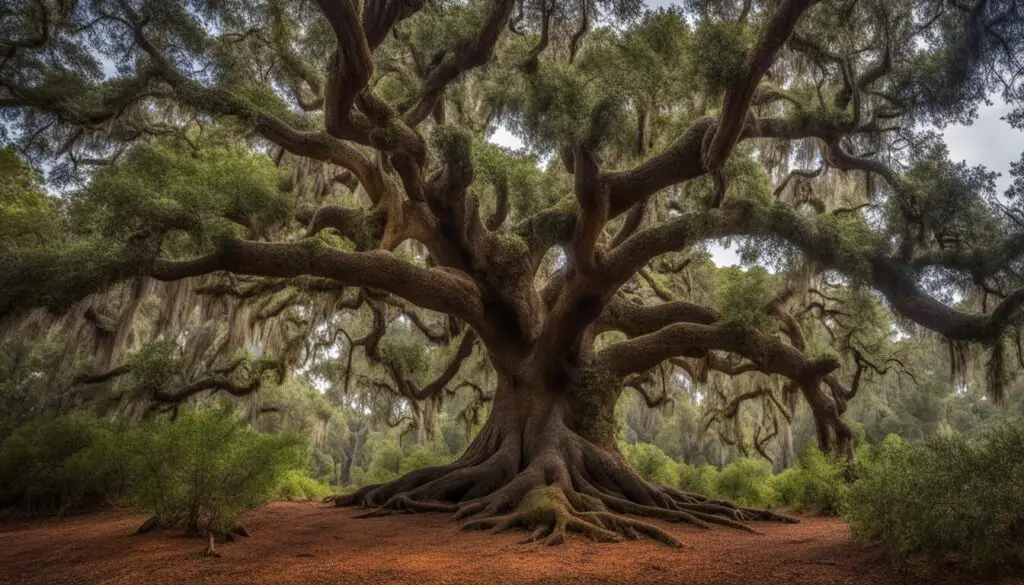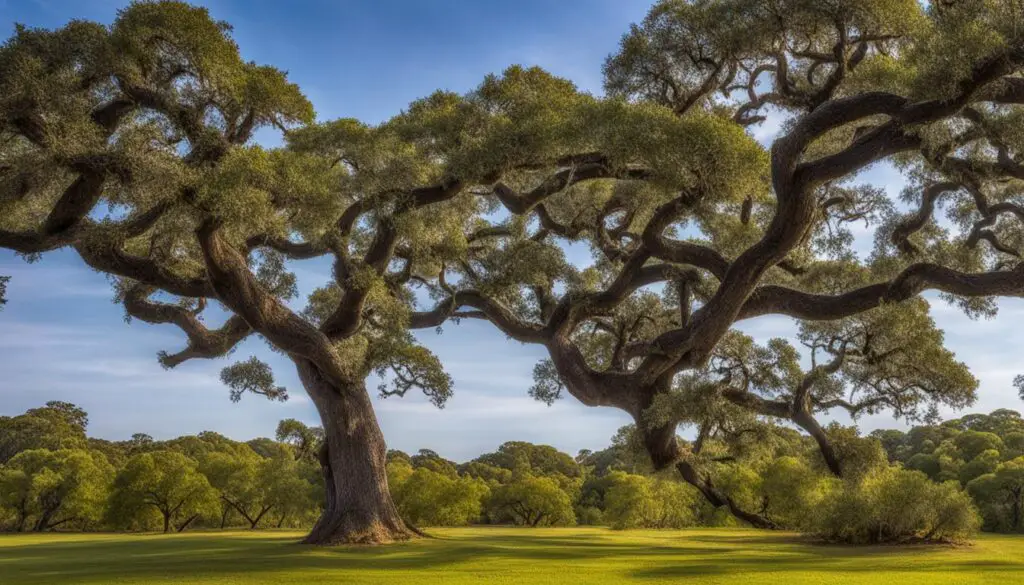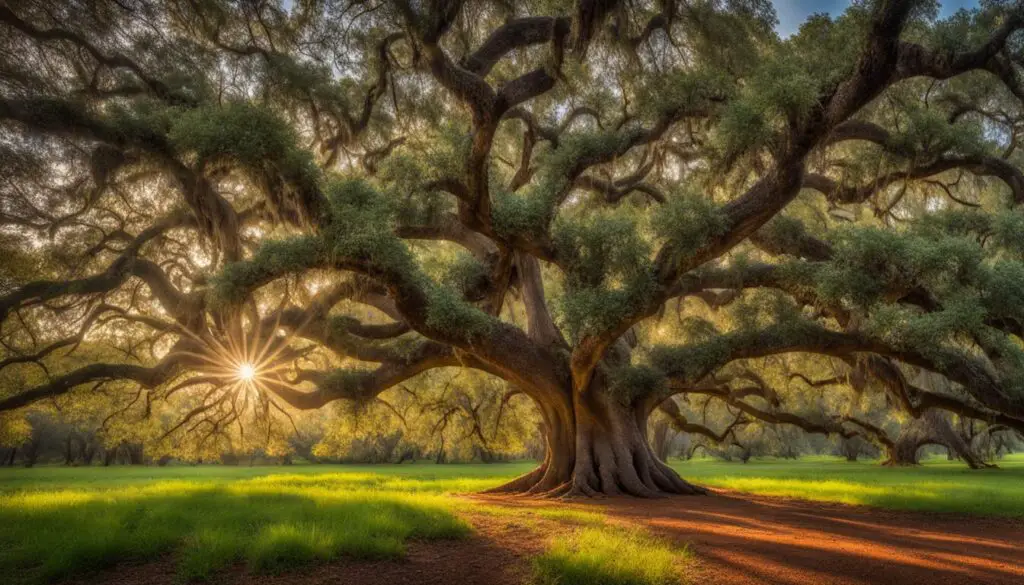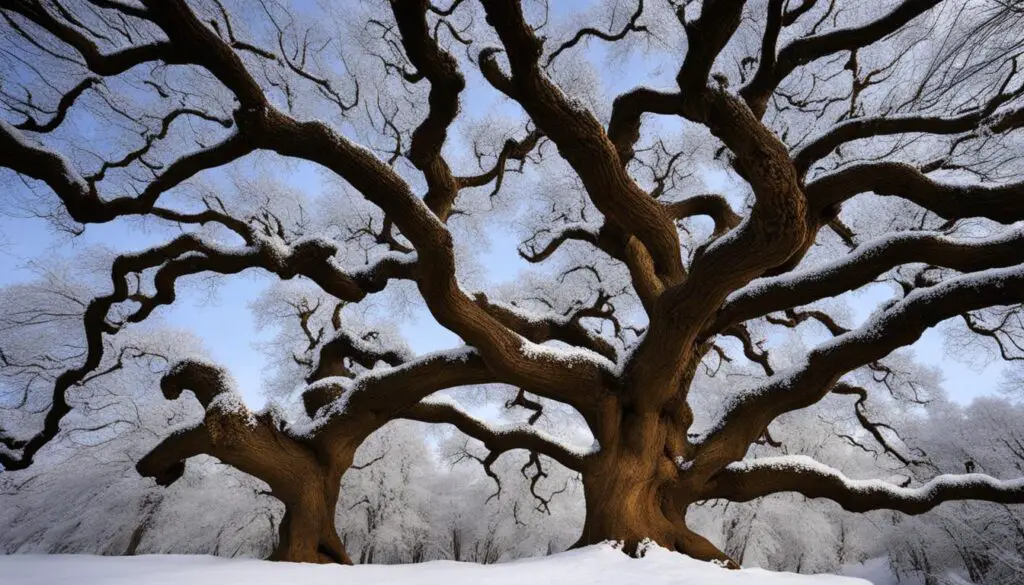Live oaks are known for their majestic beauty and have been a part of landscapes for centuries. Understanding how long live oak trees can live is important for those interested in growing and appreciating these magnificent trees. The lifespan of live oak trees can vary depending on factors such as species, growing conditions, and environmental factors. In this article, we will explore the average lifespan of live oak trees and what contributes to their longevity.
Key Takeaways:
- Live oak trees have a varying average lifespan based on species, growing conditions, and environmental factors.
- Factors such as genetics, adaptation to the environment, and resistance to pests and diseases can contribute to the longevity of live oak trees.
- Live oak trees are evergreen, retaining their lush green leaves throughout the year, which contributes to their resilience and longevity.
- Promoting the long and healthy life of live oak trees is essential for their cultivation and preservation.
- By understanding the factors that affect the lifespan of live oak trees, we can ensure their natural beauty endures for generations to come.
How Long Do Oak Trees Live?
Oak trees are renowned for their exceptional lifespan, with some species living for hundreds of years. The duration of an oak tree’s life can vary based on factors like the specific species and the surrounding environmental conditions. While certain types of oak trees can thrive for centuries, others may have shorter lifespans. In this section, we will explore the average lifespan of oak trees and the various factors that contribute to their overall longevity.
When it comes to oak tree lifespan, there is significant variability among different species. Some oak trees can live for several hundred years, with the potential to reach astounding ages. For instance, the White Oak (Quercus alba), known for its robust stature and remarkable strength, can have a lifespan of up to 450 years. Similarly, the Bur Oak (Quercus macrocarpa) has been known to survive for over 500 years.
On the other hand, certain oak species have relatively shorter lifespans. The Pin Oak (Quercus palustris), for example, typically lives for around 100 years. The lifespan of an oak tree is influenced by factors such as genetic predisposition, environmental conditions, and natural disturbances. Understanding these dynamics can provide invaluable insights into the longevity of oak trees.
Throughout their long lifespans, oak trees may encounter various challenges that can impact their overall health and vitality. Environmental stressors, including drought, extreme temperatures, and pollution, can adversely affect an oak tree’s lifespan. However, well-maintained and healthy oak trees have a higher likelihood of reaching their full potential lifespan.
To provide a better understanding of oak tree lifespans, here is a table showcasing the average lifespans of some popular oak species:
| Oak Species | Average Lifespan |
|---|---|
| White Oak (Quercus alba) | Up to 450 years |
| Bur Oak (Quercus macrocarpa) | Over 500 years |
| Pin Oak (Quercus palustris) | Around 100 years |
Table: Average lifespans of popular oak species.
As seen from the table, oak trees exhibit significant variation in lifespan, emphasizing the diverse nature of this remarkable tree species. The longevity of oak trees serves as a testament to their resilience and adaptability to different environments.
In the next section, we will explore the factors that influence the lifespan of live oak trees, shedding light on the fascinating interplay between nature and nurture. By understanding these factors, we can better appreciate and care for these magnificent trees, ensuring their preservation for future generations.
Factors Affecting Live Oak Lifespan
Several factors can influence the lifespan of live oak trees. Understanding these factors is essential for promoting the long and healthy life of live oak trees. Let’s explore the key factors that affect how long live oak trees can live.
1. Species of Oak Tree
The species of oak tree plays a significant role in determining its lifespan. Different species have varying lifespans, with some living longer than others. For example, the Southern Live Oak (Quercus virginiana) is known to have a lifespan of several hundred years, while other species may live for shorter periods.
2. Environmental Conditions
Environmental conditions, such as soil composition and climate, also impact the lifespan of live oak trees. These factors directly affect the tree’s ability to thrive and grow. Live oaks prefer well-drained soil and thrive in regions with a moderate climate.
3. Disease, Pests, and Human Activities
Disease, pests, and human activities can all have detrimental effects on the health and longevity of live oak trees. Infectious diseases, such as oak wilt or root rot, can severely impact the tree’s ability to survive. Pests, like oak borers or oak scale insects, can cause significant damage. Human activities, such as improper pruning or construction damage, can also weaken live oak trees.

By understanding and addressing these factors, we can ensure the long and healthy lifespan of live oak trees. Implementing proper care, including regular maintenance and protection against diseases and pests, is crucial for preserving these majestic trees for future generations.
Life Cycle of Live Oak Trees
The life cycle of a live oak tree is a fascinating process. It begins with an acorn and progresses through various stages of growth until the tree reaches maturity. The time it takes for a live oak tree to reach maturity can vary, depending on environmental factors and the tree’s overall health.
Live oak trees start their life as acorns, which are the seeds produced by mature trees. Acorns are typically dropped in the fall, and if conditions are favorable, they will sprout and begin their journey towards becoming a mature tree. The germination process can take several weeks to a few months, depending on factors such as moisture and temperature.
Once the acorn sprouts, it will develop a taproot that anchors the tree in the ground and helps it absorb water and nutrients. The taproot will continue to grow and develop as the tree matures.
As the live oak tree grows, it will begin to produce leaves and branches. These branches will continue to grow and develop over time, forming the distinctive canopy that live oak trees are known for.
The growth rate of live oak trees can vary depending on factors such as sunlight, soil composition, and water availability. In ideal conditions, live oak trees can grow several feet per year. However, factors such as competition for resources or environmental stress can slow down their growth rate.
It typically takes several decades for a live oak tree to reach maturity, with some specimens taking over 50 years to fully develop. Once a live oak tree reaches maturity, it can continue to grow and thrive for hundreds of years.
To visualize the life cycle of a live oak tree, refer to the image below:
| Stage | Description |
|---|---|
| Acorn | The seed of a live oak tree, produced by mature trees. |
| Germination | The process of an acorn sprouting and developing into a young tree. |
| Sapling | A young live oak tree with a developing root system and branches. |
| Maturity | A fully developed live oak tree with a distinct canopy and established root system. |
| Longevity | The extended lifespan of a live oak tree, which can span hundreds of years. |
The life cycle of a live oak tree is a testament to their resilience and longevity. From humble acorns to magnificent trees, live oaks play a vital role in our ecosystems and landscapes for generations to come.
Identification of Live Oak Trees
Live oak trees, belonging to the oak family, exhibit distinct characteristics that differentiate them from other tree species. Identifying live oak trees can be easily accomplished by observing their unique features, particularly their foliage.
One of the key characteristics of live oak trees is their leaves, which can have serrated edges or be smooth and rounded. This variation in leaf shape can provide valuable clues for identification.
Furthermore, the size, shape, and color of the leaves also contribute to the identification process. Live oak tree leaves are typically elongated and range from deep green to a vibrant yellow-green color.
Understanding the different varieties and types of live oak trees can also aid in their identification. Some popular varieties include the Southern Live Oak (Quercus virginiana) and the Spanish Oak (Quercus texana). Each variety may have its own distinct characteristics, such as leaf size or growth pattern, that can help differentiate them from other species.

Observing these distinctive characteristics and familiarizing oneself with the various types of live oak trees will ensure accurate identification and an enhanced appreciation for these magnificent trees.
Live Oak Tree Lifespan and Growth Conditions
Live oak trees are known for their longevity, with some species capable of living for hundreds of years. However, the lifespan of a live oak tree can vary depending on several factors, including its species and specific growth conditions. Understanding these factors is essential for successfully cultivating and preserving these magnificent trees.
The lifespan of a live oak tree largely depends on its species. Some varieties have been known to live for several hundred years, while others can surpass a millennium. For example, the Southern Red Oak (Quercus falcata) typically lives for around 200 to 300 years, while the White Oak (Quercus alba) can reach an age of 300 to 600 years.
Aside from species, the growth conditions of live oak trees are crucial for their longevity. They thrive in well-drained soil, as excessive moisture can lead to root rot and other diseases. Live oak trees also require an adequate amount of sunlight to support their growth and health. These conditions, in combination with their resilience and adaptability, contribute to the impressive lifespan of these trees.
When it comes to height, live oak trees can range from medium-sized to towering giants. On average, they grow to be around 40 to 60 feet tall. However, certain species can exceed this height, reaching up to 80 feet or more. The majestic stature of live oak trees adds to their visual appeal and enhances the landscapes they inhabit.
To give you a better understanding of the lifespan and growth conditions of live oak trees, let’s take a look at a table showcasing the lifespan and average height of different live oak tree species:
| Live Oak Tree Species | Lifespan | Average Height |
|---|---|---|
| Southern Red Oak (Quercus falcata) | 200-300 years | 60-80 feet |
| White Oak (Quercus alba) | 300-600 years | 60-100 feet |
| Chestnut Oak (Quercus montana) | 200-400 years | 60-80 feet |
These examples demonstrate the varying lifespans and heights of live oak tree species. By providing the right growth conditions and care, you can help these magnificent trees thrive and reach their full potential.
Examples of Live Oak Tree Lifespan and Height
Live oak trees are found in various species, each with its own unique lifespan and height range. Understanding the specific examples of live oak tree lifespan and height can provide insights into the diversity and longevity of these remarkable trees. Some notable live oak tree species include the Southern Red Oak, White Oak, and Chestnut Oak.
The lifespan of live oak trees can vary depending on the species. Here are some examples:
- The Southern Red Oak (Quercus falcata) has an average lifespan of 300 to 500 years. This species is known for its robust growth and ability to adapt to various soil conditions.
- The White Oak (Quercus alba) is a long-lived species with an average lifespan of 200 to 300 years. It is characterized by its distinctive white bark and wide-spreading branches.
- The Chestnut Oak (Quercus montana) is known for its durability and can live up to 500 years. It is commonly found in upland forests and has a tall, straight trunk.
The height of live oak trees can also vary among species. Some examples of live oak tree height include:
- The Southern Red Oak can reach heights of up to 70 feet, towering over its surroundings.
- The White Oak generally grows to a height of 50 to 80 feet, creating a majestic presence in the landscape.
- The Chestnut Oak can grow to heights ranging from 60 to 70 feet, making it an impressive sight in forests and parklands.
These examples demonstrate the range of lifespan and height that live oak trees can achieve based on their species. It is important to note that individual trees may vary within a species, influenced by factors such as growing conditions and environmental factors.

Having a visual representation can help us appreciate the grandeur of live oak trees. The image above showcases the beauty and stature of a live oak tree, showing its height and spread.
Why Some Oak Trees Live Longer
Certain factors contribute to why some oak trees live longer than others. Oak trees have developed mechanisms to resist diseases, pests, and environmental challenges, which allows them to thrive for extended periods. Factors such as genetics, adaptation to their environment, and resistance to pests and diseases play a role in the longevity of oak trees. A deeper understanding of these factors can shed light on how oak trees can live for centuries.
Understanding the factors that influence oak tree longevity can provide valuable insights into promoting their health and longevity. Let’s explore some of these factors:
| Factors Influencing Oak Tree Longevity |
|---|
| Genetics |
| Adaptation to Environment |
| Resistance to Pests and Diseases |
Genetics: The genetic makeup of an oak tree can influence its lifespan. Some oak tree species inherently possess genes that contribute to their longevity, allowing them to withstand environmental stresses and thrive for centuries.
Adaptation to Environment: Oak trees have evolved to adapt to different environmental conditions. Their ability to tolerate and adapt to changes in temperature, moisture levels, and soil conditions contributes to their longevity.
Resistance to Pests and Diseases: Oak trees have built-in defenses against pests and diseases. They produce natural compounds that repel insects and pathogens, protecting them from infestations and diseases that could otherwise shorten their lifespan.
By understanding these factors and implementing appropriate care and maintenance strategies, it is possible to promote the long and healthy life of oak trees.
Oak Trees’ Ability to Survive Winter and Environmental Changes
Oak trees possess remarkable adaptation strategies that allow them to survive harsh winters and environmental changes. During the winter months, oak trees undergo a process called dormancy, where they enter a period of rest and conserve resources to withstand the challenging conditions. As part of this survival mechanism, oak trees shed their leaves, reducing the amount of energy required for maintenance.
This period of dormancy is crucial for oak trees as it helps them conserve energy and protect themselves from freezing temperatures. The shedding of leaves also reduces the risk of damage caused by snow, ice, and strong winds. Without the burden of leaves, the oak tree’s branches become more flexible, decreasing the chance of breakage during winter storms.
One of the fascinating adaptations that enable oak trees to survive winter is their innovative cellular structure. Deep within the tree, within the buds and roots, exist specialized cells called meristematic cells. These cells have the incredible ability to remain active even during dormancy, allowing the oak tree to regenerate and grow once the conditions improve.

The meristematic cells within oak trees have the potential to develop into new leaves, branches, and even roots when the dormant period ends. This adaptation ensures the tree’s ability to recover and resume active growth when winter subsides. It is a testament to the resilience and adaptability of oak trees, enabling them to thrive in ever-changing environments.
The remarkable survival strategies of oak trees make them resilient and capable of adapting to various environmental changes. Whether it be surviving extreme temperatures, coping with changes in precipitation, or withstanding natural disasters, oak trees have evolved to endure numerous challenges. This adaptability has contributed to their longevity and prominence in a wide range of ecosystems.
Understanding how oak trees survive winter and adapt to environmental changes is not only fascinating but also crucial for their conservation and successful cultivation. By appreciating and supporting the natural strategies of these remarkable trees, we can ensure the preservation of their beauty and ecological significance for generations to come.
Live Oak Trees and Their Lifespan as Evergreen Trees
Live oak trees are truly remarkable as they maintain their lush green foliage throughout the year. Unlike deciduous oak trees that shed their leaves during the winter, live oak trees remain evergreen, showcasing their vibrant beauty in all seasons. This unique characteristic sets them apart and contributes to their longevity and resilience.
As evergreen trees, live oaks have the advantage of continuous photosynthesis, allowing them to produce energy and nutrients throughout the year. This sustained growth and nutrient production support the tree’s overall health and contribute to its long lifespan. The ability to retain leaves also helps protect the tree from harsh weather conditions and provides shelter for wildlife.
“Live oak trees remain evergreen, showcasing their vibrant beauty in all seasons.”
Additionally, the evergreen nature of live oak trees enables them to adapt to changing environmental conditions more effectively. While deciduous oak trees primarily rely on leaf shedding as a survival strategy during unfavorable seasons, live oaks can continue to perform vital functions, such as carbon sequestration and oxygen production, year-round.
Furthermore, the evergreen foliage of live oak trees adds a touch of elegance to any landscape, providing a constant source of shade, privacy, and aesthetic appeal. Their deep green leaves create a sense of tranquility and serve as a visual anchor, enhancing the overall beauty of the surroundings.
Overall, the lifespan of live oak trees as evergreens is influenced by their ability to sustain foliage, perform photosynthesis continuously, adapt to changing environments, and contribute to the ecological balance. The combination of these characteristics makes live oak trees an enduring symbol of strength and beauty.
Lifespan Comparison: Live Oak Trees vs. Deciduous Oak Trees
Here’s a comparison between the lifespan of live oak trees as evergreens and deciduous oak trees that shed their leaves:
| Tree Type | Average Lifespan |
|---|---|
| Live Oak Tree (evergreen) | Several hundred years to over 1,000 years |
| Deciduous Oak Tree | Approximately 100-300 years |
Conclusion
In conclusion, live oak trees have an impressive lifespan, with some living for hundreds of years. The longevity of these majestic trees is influenced by several factors, including the species of oak, environmental conditions, and their ability to resist diseases and pests. Understanding the life cycle of live oak trees, their growth conditions, and ways to promote their longevity is crucial for their successful cultivation and preservation.
By appreciating and caring for live oak trees, we can ensure that their natural beauty endures for generations to come. Providing optimal growing conditions, such as well-drained soil and sufficient sunlight, along with regular maintenance and disease prevention, can help promote the longevity of live oak trees. In addition, it is important to raise awareness about the importance of preserving these iconic trees and their habitats through education and conservation efforts.
The lifespan of live oak trees is a testament to their resilience and adaptability. By protecting and supporting these remarkable trees, we contribute to the overall health and biodiversity of our ecosystems. As we marvel at the grandeur of live oak trees, let us also embrace the responsibility to promote their longevity, ensuring that future generations can continue to enjoy the presence of these magnificent giants in our landscapes.
FAQ
How long do live oak trees live?
Live oak trees have an impressive lifespan, with some species living for hundreds of years.
What factors affect the lifespan of live oak trees?
The lifespan of live oak trees can be influenced by the species of oak, environmental conditions, disease, pests, and human activities.
What is the life cycle of live oak trees?
Live oak trees begin as acorns and progress through various stages of growth until they reach maturity. The time it takes for a live oak tree to mature can vary depending on environmental factors and overall health.
How can I identify live oak trees?
Live oak trees can be identified by observing their leaves, which can have serrated edges or be smooth and rounded. Size, shape, and color of the leaves can also provide clues for identification.
What are the growth conditions for live oak trees and how long do they live?
Live oak trees can live for hundreds of years in optimal conditions, such as well-drained soil and the right amount of sunlight. They can reach heights of up to 60 feet or more.
Can you provide examples of live oak tree lifespan and height?
Examples of live oak tree lifespan range from several hundred years to over 1,000 years, with certain species growing taller than others.
Why do some oak trees live longer than others?
Factors such as genetics, adaptation to the environment, and resistance to pests and diseases contribute to the longevity of oak trees.
How do oak trees survive winter and environmental changes?
Oak trees go dormant during winter, shedding their leaves and conserving resources until conditions improve. They have adaptations that allow for regeneration and growth once the weather becomes more favorable.
What is the lifespan of live oak trees as evergreens?
Live oak trees retain their lush green leaves throughout the year, contributing to their longevity and resilience.

